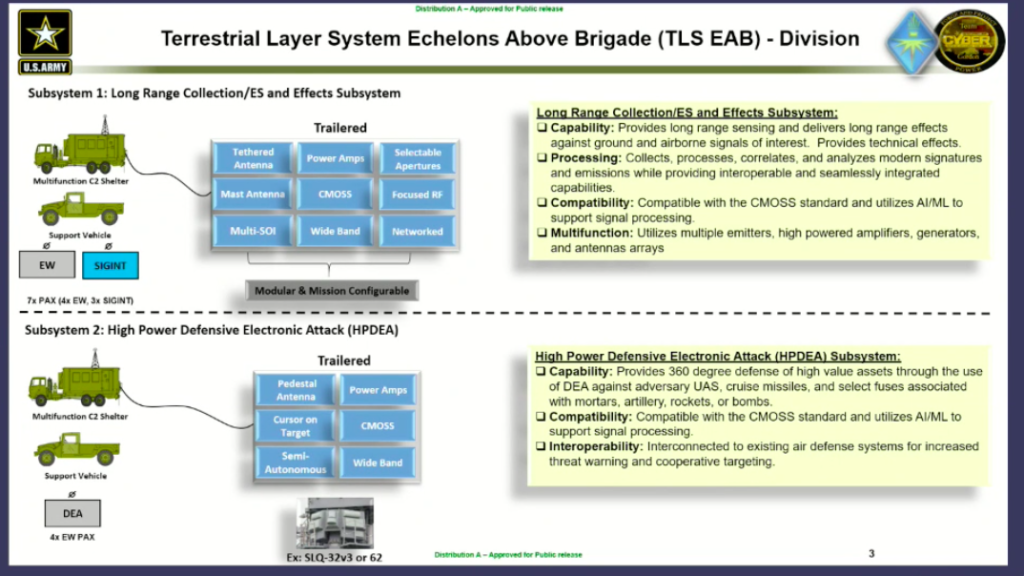Air Warfare, Land Warfare, Networks / Cyber
Army Wants New Mega-Jammer In 2023: TLS-EAB

Army concept for the two variants of the high-level cyber/EW/SIGINT system, TLS-EAB
WASHINGTON: The Army officially asked industry today to help take a big step towards repairing the Army’s long-neglected EW corps and countering Russian and Chinese jamming – and it’ll have an unexpected missile defense dimension as well.
Boeing and Lockheed are still building rival prototypes for the Army’s next-generation cyber/electronic warfare vehicle, the Terrestrial Layer System set to enter service in 2022. The new system, known as TLS-EAB — will be TLS’s much bigger brother. The service has set a pretty brisk schedule, talking of fielding something by the end of 2023.
The original-flavor TLS, aka TLS-BCT, will fit on an 8×8 Stryker armored vehicle and accompany frontline Brigade Combat Teams. TLS-Echelons Above Brigade will fill a pair of heavy trucks, probably Oshkosh FMTVs, Army officials unveiled today:
- One truck will carry sensors, transmitters, and a tethered drone or aerostat to detect enemy signals, triangulate their locations for artillery and airstrikes, and disrupt them electronically with a combination of jamming, wireless hacking, and deceptive signals. It’ll be crewed by eight soldiers, four specializing in cyber/electronic warfare and four in signals intelligence. There will likely be sub-variants, for example with a division-level system designed to frequently relocate, while a Multi-Domain Task Force might accept a less mobile version with more range and power. But overall, this long-range offensive cyber/EW/SIGINT capability is essentially a supersized version of what the TLS-BCT will do, albeit operating over much greater distances.
- The other truck, however, adds a dimension absent from the brigade-level TLS-BCT: a high-powered but relatively short-ranged defensive EW capability to protect key sites like division, corps, and theater command posts. It’ll be crewed by four electronic warfare soldiers, but there’s no SIGINT on this variant. Instead, it’ll have an “electronic countermeasure point defense suite” – again, using a mix of jamming, wireless hacking, and deceptive signals – to decoy or disable incoming enemy drones, missiles, rockets, and artillery rounds, many of which rely on radar for guidance and fusing.
Because it’s mounted on trucks, TLS-EAB can be a lot bigger and more powerful than the Stryker-mounted TLS-BCT or the drone-mounted jamming/sensing system known as MFEW-Air-Large. But it will share data with those systems, because they’ll be closer to the front line and/or able to fly over obstacles to see distant threats.
TLS-EAB will also link to other Army and interservice systems like the EWPMT command-and-control software and the TITAN satellite terminal. The defensive suite, in particular, will get warning of incoming threats from air & missile defense networks – which we can presume includes the Army’s forthcoming IBCS – to “national technical means,” such as spy satellites.
Each of the Army’s future jammers plugs into a larger electronic warfare network.
Now, the three Army colonels who briefed the AOC CEMAlite conference this afternoon didn’t provide any details on what kind of incoming missiles the TLS-EAB defensive suite is meant to stop. Actually jamming an inbound hypersonic or ballistic missile might be prohibitively hard since those weapons fly so fast – Mach 5 and up – and may only be in range for seconds. But if you deceive the enemy’s reconnaissance and targeting systems into shooting at a decoy instead of the real target, it doesn’t matter how fast their missiles are — they’ll still miss.
It’s also worth noting that the Army hasn’t locked down the formal requirements for this system – a draft Abbreviated Capabilities Development Document (ACDD) is in the works – and the service intends to leave plenty of leeway for industry to propose out-of-the-box ideas. “These are our initial concept ideas and not intended to constrain or limit the industrial solution space,” said Col. Jennifer McAfee. “Please think of this is a starting point in a long and mutually beneficial conversation.”
Points of contact for companies interested in participating in TLS.
That said, all proposals need to rely on an Army-sponsored software framework known as Photon and a set of technical standards known as CMOSS. Both are intended to let the service plug and play components from different vendors instead of getting locked into one company’s proprietary solution that’s not compatible with other people’s innovations. There’s also an official Software Development Kit (SDK) to let companies integrate their sensors into the Army-standard systems.
What the Army rolled out today was a draft concept of operations (CONOP) for TLS-EAB, explained the Army project manager, Col. Kevin Finch. Looking ahead, he outlined an ambitious schedule:
- January 2021: The Army will hold an initial industry day for interested vendors (TBD whether it’ll be in-person or online).
- February-March 2021: Individual vendors will have the opportunity to meet one-on-one with Army officials. Meanwhile the service will put together a draft Request For Proposals (RFP) and circulate it for industry feedback.
- June 2021: a second industry day.
- July 2021: the release of the final RFP and the official launch of what’s known as a Middle-Tier Acquisition process.
- Fall 2023 (first quarter of federal fiscal year 2024): the First Unit Equipped (FUE) will receive prototype TLS-EAB vehicles.
If TLS-EAB can stick to that 2023-2024 timeline, it’ll enter service along with a host of new long-range Army systems, from howitzers and hypersonics to intermediate-range missiles and missile defense lasers. But between the budgetary hit from COVID and the upcoming election, it’s far from certain the Army can afford it all.
Tentative timeline for Terrestrial Layer System – Echelons Above Brigade